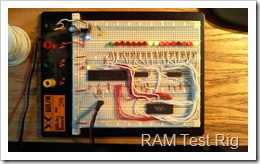 For my birthday this year my wife got me a Spare Time Gizmos ELF 2000 kit, a re-interpretation of the original 1802-based computer that I (and many others) built from plans in Popular Electronics.
For my birthday this year my wife got me a Spare Time Gizmos ELF 2000 kit, a re-interpretation of the original 1802-based computer that I (and many others) built from plans in Popular Electronics.
Just like the first one that I built, this one had a few problems when I first turned it on. Finding and fixing a bad connection in an IDC socket was fairly easy, and I found the cold solder joint on the switch panel after just a little more work. What was harder was the fact that some memory locations just didn't seem to be changing, and I couldn't figure out why.
So I built a test rig for the 32K static RAM on the ELF2K. I used a Picaxe 40X1 as the brains, two 74HC595 chips to latch the 16-bit address required, and a handful of LEDs to show me what's going on.
I used PortC to read and write data to the RAM chip. I had some difficulty getting the bi-directional data bus to work until I put dirs= statements in the code to explicitly change from output to input when writing then reading the test data.
Since PortC was in use, I couldn't use the hardware SPI port, so I used the simple bit-banged serial protocol from the manual.
Once I had the test rig up and running it started indicating memory errors throughout the RAM chip, but especially on the last page of memory, the page that the ELF2K uses for it's system data page, and where the OS on the ELF2K was indicating there was a problem.
I've ordered a couple more RAM chips that should be here tomorrow. Once I've got a known good RAM chip to install in the ELF2K I'll be one step closer to getting it to work.